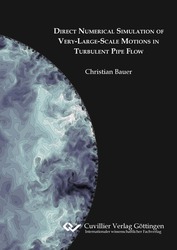| Departments | |
|---|---|
| Book Series (96) |
1378
|
| Nachhaltigkeit |
3
|
| Gesundheitswesen |
1
|
| Humanities |
2364
|
| Natural Sciences |
5406
|
| Engineering |
1793
|
| Engineering | 292 |
| Mechanical and process engineering | 862 |
| Electrical engineering | 686 |
| Mining and metallurgy | 30 |
| Architecture and civil engineering | 75 |
| Common |
98
|
|
Leitlinien Unfallchirurgie
5. Auflage bestellen |
|
Advanced Search
Direct Numerical Simulation of Very-Large-Scale Motions in Turbulent Pipe Flow (English shop)
Christian Bauer (Author)Preview
Extract, PDF (290 KB)
Table of Contents, PDF (29 KB)
Turbulent pipe flow is not only of importance to engineering applications but also of fundamental interest to the study of wall-bounded turbulence. In the present work, the interaction of the so-called very-large-scale motions (VLSMs) with the near-wall, small-scale turbulence is explored by means of direct numerical simulation for friction Reynolds numbers up to Reτ = 2880 and pipe lengths up to L = 42R. Besides, the convergence and the scaling of different order moments of the velocity distribution are studied and also discussed with regard to VLSMs. The subsequent analysis of the streamwise energy budget equation of the filtered velocity field reveals that VLSMs obtain their energy from the mean velocity field via a production mechanism similar to the one known from the near-wall cycle. Moreover, the different energy budget terms are investigated by means of statistical averages, instantaneous flow field visualisations, and three-dimensional correlations, wherein the backscattering phenomenon is also dealt with. In brief, the research sheds new light on our understanding of the interaction between VLSMs and the near-wall cycle and leads to a better grasp of turbulent pipe flow in general.
| ISBN-13 (Hard Copy) | 9783736973695 |
| ISBN-13 (eBook) | 9783736963696 |
| Final Book Format | A5 |
| Language | English |
| Page Number | 244 |
| Lamination of Cover | glossy |
| Edition | 1 |
| Publication Place | Göttingen |
| Place of Dissertation | Ilmenau |
| Publication Date | 2021-02-01 |
| General Categorization | Dissertation |
| Departments |
Engineering
Technical mechanics |
| Keywords | direct numerical simulation, turbulent pipe flow, small-scale motions, very-large-scale motions, turbulence, wall-bounded turbulence, boundary layer, coherent structures, velocity spikes, velocity streaks, high-order statistics, velocity correlation, one-point statistics, two-point statistics, convergence, scaling, Reynolds stresses, skewness, flatness, scale interaction, turbulent kinetic energy, inter-scale energy flux, energy budget, production, dissipation, diffusion, cut-off filter, finite-volume scheme, Leapfrog-Euler scheme, cylindrical coordinates, Navier-Stokes equation, near-wall cycle, outer-flow region, inner-flow region, Reynolds number dependence, domain length, backscattering, energy cascade, sweeps, ejections, Direkte numerische Simulation, Turbulente Rohrströmung, kleinskalige Strukturen, Superstrukturen, Turbulenz, Wandnahe Turbulenz, Grenzschichtströmung, Kohärente Strukturen, velocity spikes, velocity streaks, Höhere Ordnung Statistik, Geschwindigkeitskorrelationen, Ein-Punkt Statistik, Zwei-Punkt Statistik, Konvergenz, Skalierung, Reynolds-Spannungen, Schiefe, Flachheit, Skaleninteraktion, Turbulente kinetische Energie, Interskalenenergiefluss, Energiebilanz, Produktion, Dissipation, Diffusion, Cut-off Filter, Finite-Volumen Methode, Leapfrog-Euler Methode, Zylinderkoordinaten, Navier-Stokes Gleichung, Wandnaher Zyklus, Äußere Region, Innere Region, Reynoldszahlabhängigkeit, Domänengröße, backscattering, Energiekaskade, sweeps, ejections, Fluidbewegung, Fluid Motion, Strömungsgeometrie |
| URL to External Homepage | https://scart.dlr.de/site/research-projects/direct-numerical-simulation-and-large-eddy-simulation-of-turbulent-pipe-and-channel-flows/index.htm |








